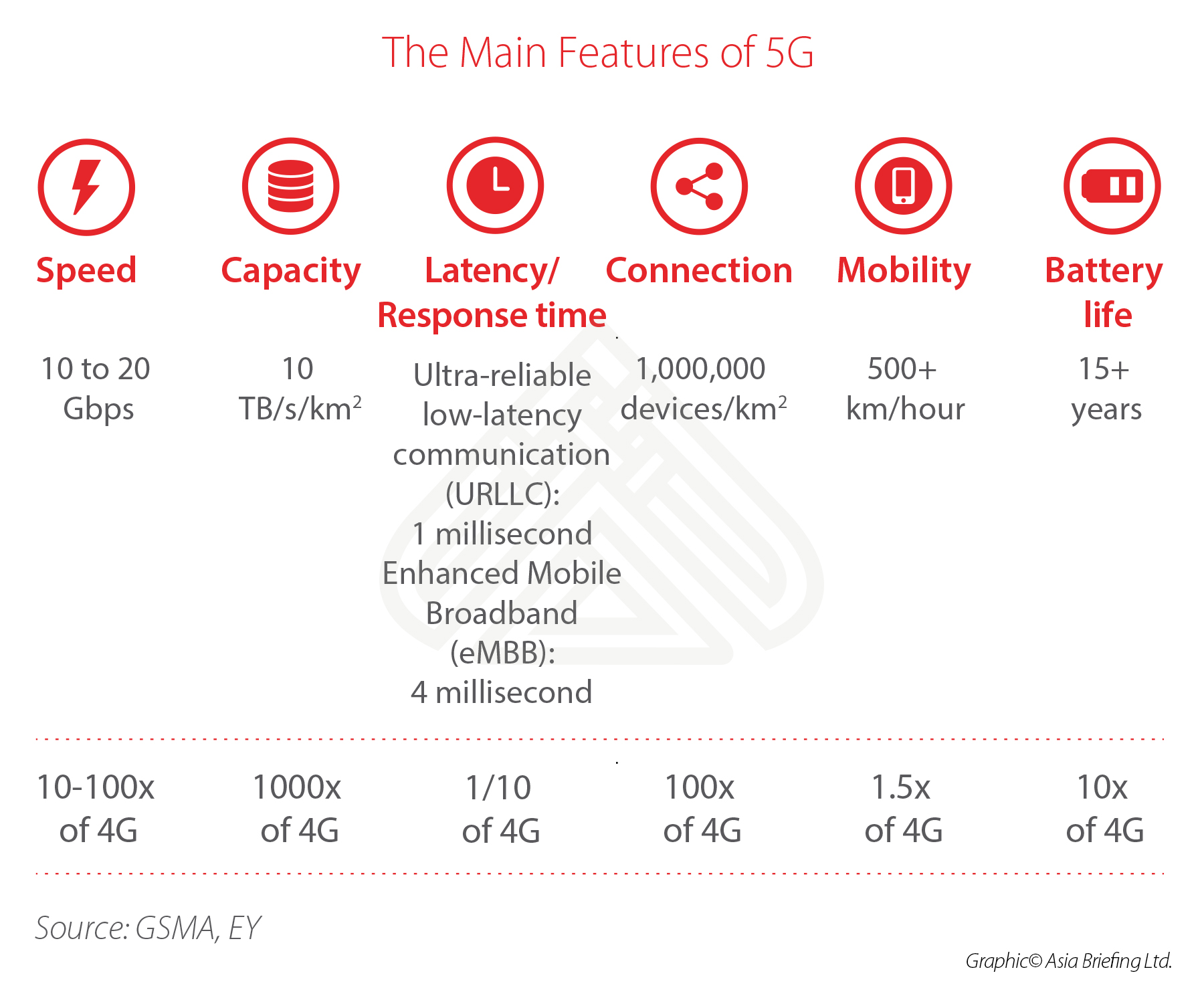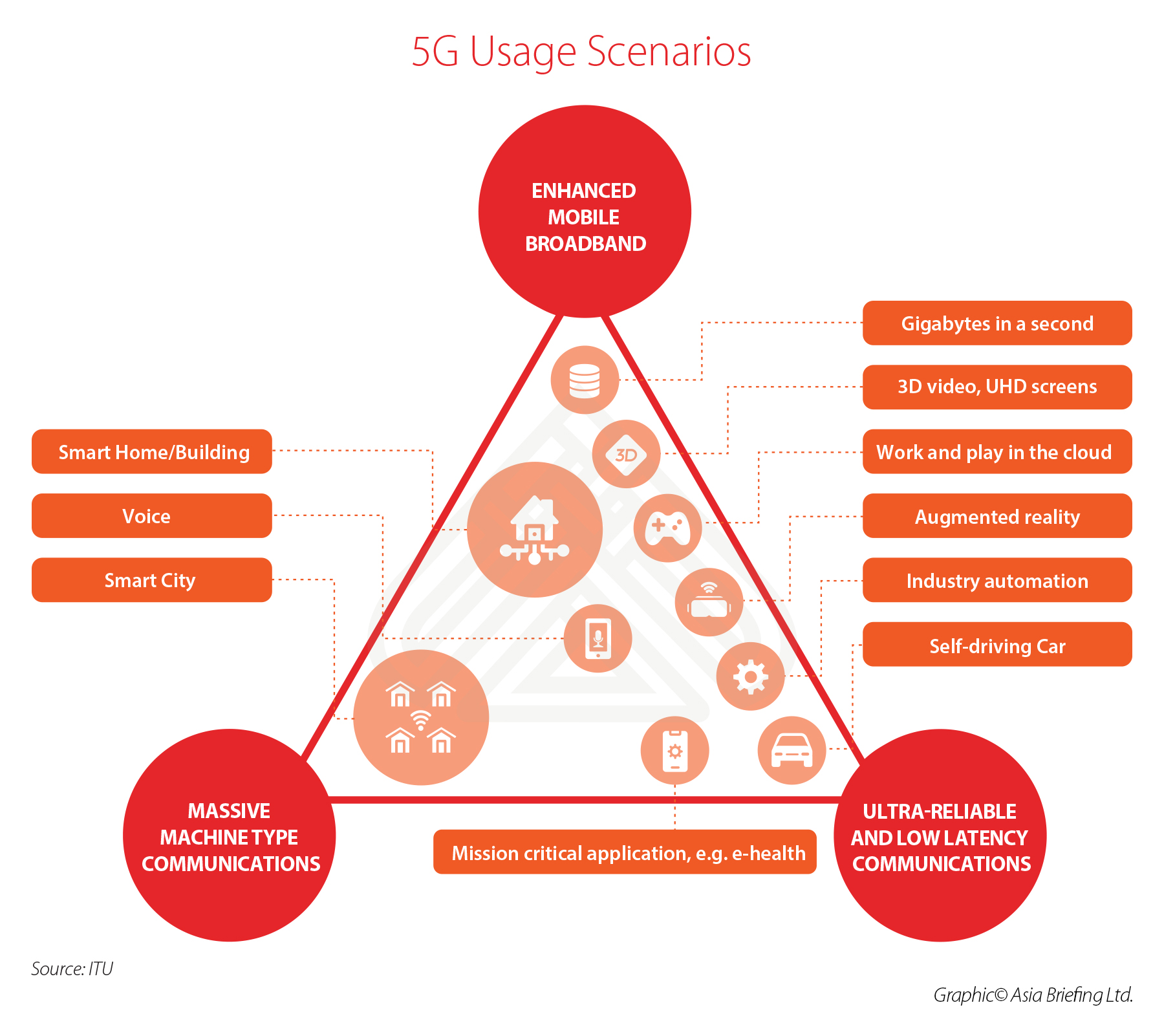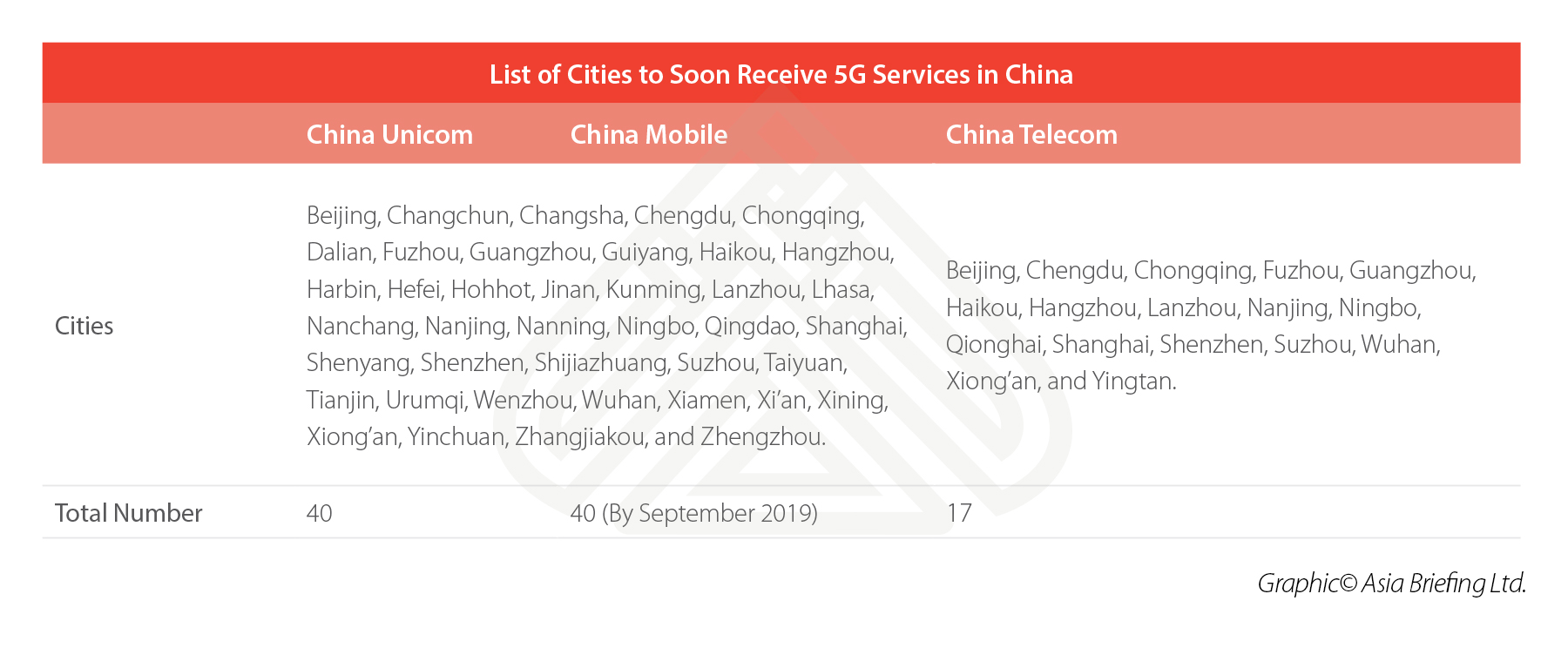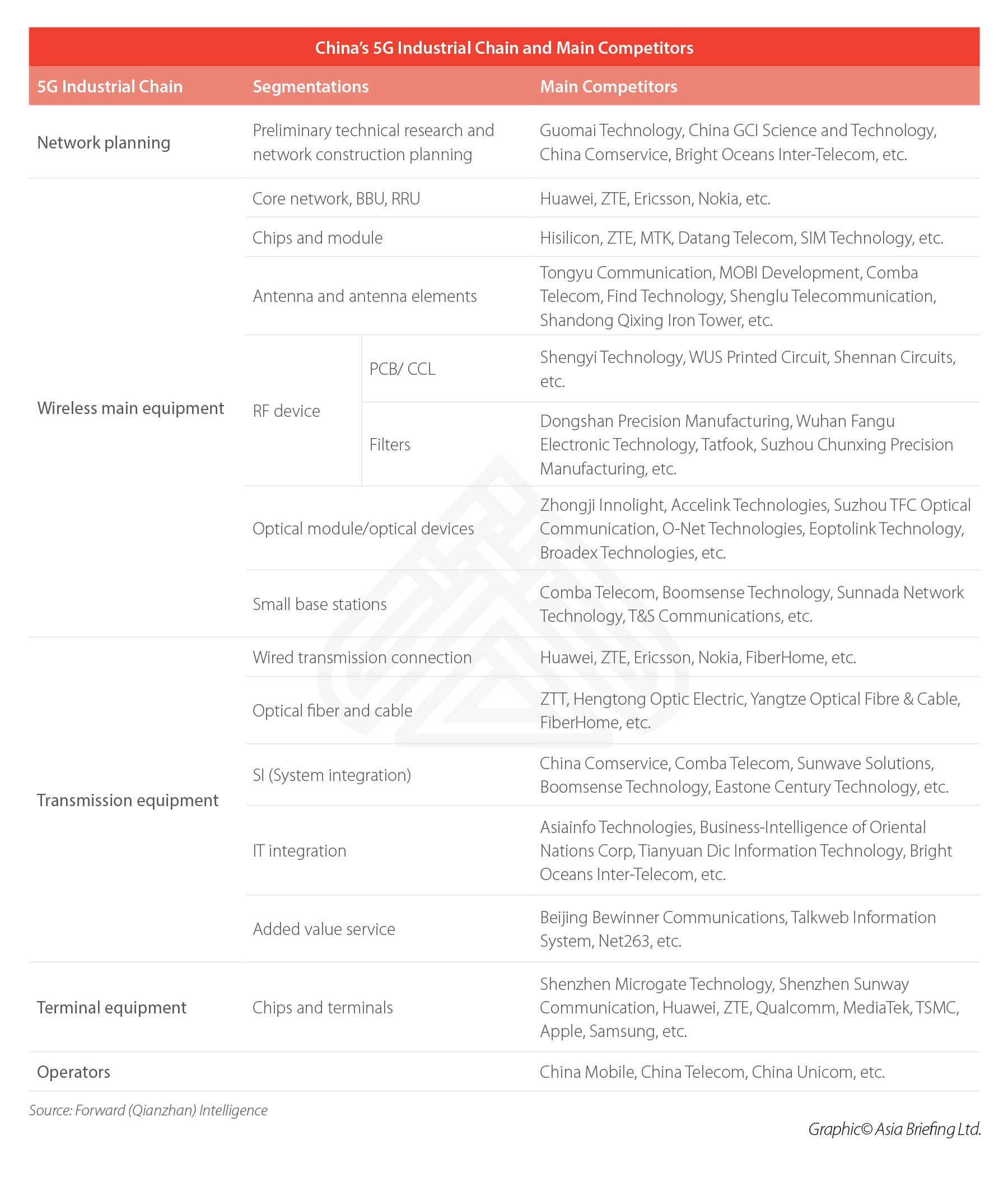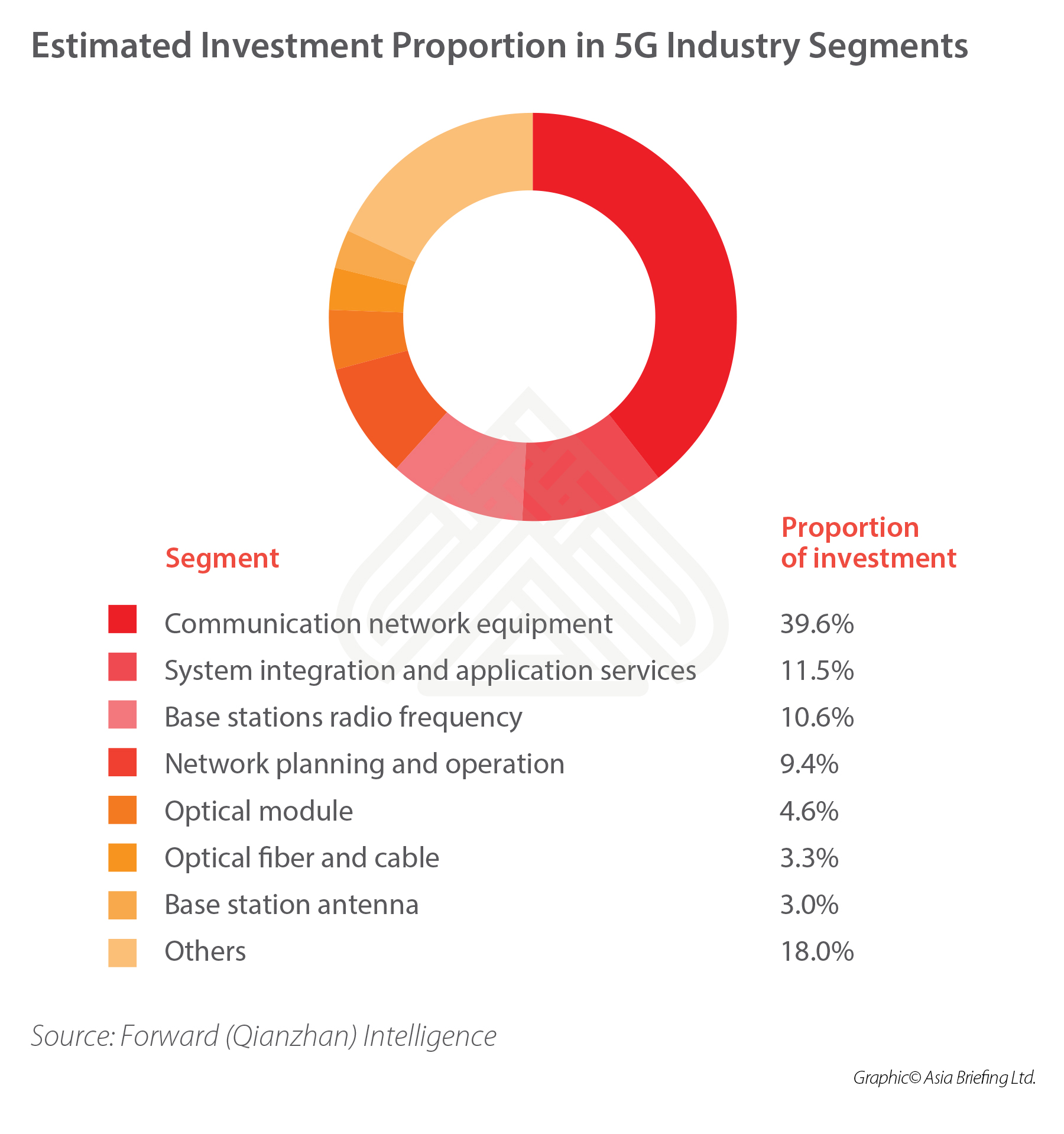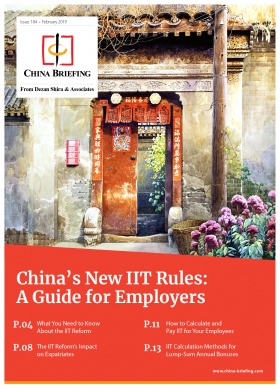China’s 5G Roll-Out: What Should Foreign Investors Expect
China’s 5G roll-out is well under way. On June 6, 2019, China’s Ministry of Industry and Information Technology (MIIT) granted 5G licenses for commercial use to four telecom operators, half a year ahead of schedule, making China the fifth country to commercialize 5G, following South Korea, the US, Switzerland, and the UK.
In 2017, 5G was first included in the government’s work report of the two sessions. At the end of 2018, the Central Economic Work Conference (CEWC) redefined “infrastructure construction” – stating that 5G, artificial intelligence (AI), industrial Internet, and Internet of things (IoTs) constituted “new type of infrastructure construction” and key tasks for China in 2019.
In this article, we assess China’s intent to lead the development of 5G capacity and the role for foreign investors in China’s emerging 5G market.
What is 5G?
After missing opportunities in the 2G, 3G, and 4G eras, China wants to be at the forefront of 5G technology.
5G, or the fifth-generation mobile network, will play a much bigger role than its predecessors due to its ability to facilitate rapid advances in internet communications technologies (ICT).
Compared with 4G LTE, 5G is not just about faster speed, but also facilitating bigger capacity, quicker response time, and more connections.
Based on these characteristics, the International Telecommunication Union (ITU) defines three major application scenarios of 5G: enhanced mobile broadband (eMBB), massive machine type communications (mMTC), and ultra-reliable and low-latency communication (uRLLC).
An early deployment of 5G technology could be achieved through enhanced mobile broadband (eMBB) – whereby users benefit from enhanced communication experience, corresponding to the development of high-traffic mobile broadband services, such as streaming 3D/ultra-high definition (HD) video and augmented reality/virtual reality/mixed reality (AR/VR/MR).
The ultra-reliable and low-latency communication (URLLC) is designed for applications that require highly reliable transmission of information and less response time, such as autonomous vehicle, remote surgery, and factory automation.
The massive machine type communications (mMTC) is mainly used for the communication between physical objects, which can be applied in scenarios requiring sensing and data collection, such as smart cities, smart homes, and wearable devices. The market application of mMTC is exponential when it comes to the internet of things (IoT).
Therefore, developing 5G networks capability is not only about improving basic consumer experience of the internet; it is set to have a wide-ranging impact on innovation, research, and technologies used across multiple industries.
Further, it is certain that 5G and the fusion of 5G, AI, and IoT technologies will propel the growth of economic power in increasingly digital societies.
The American semiconductor and telecommunications equipment company, Qualcomm, estimates that 5G’s full economic effect will be realized across the world in 2035. At that time, 5G will support a wide range of industries to potentially produce up to US$12 trillion worth of goods and services.
China Academy of Information and Communications Technology (CAICT) estimates that by 2030, the direct and indirect industrial output driven by 5G in the country could reach RMB 6.3 trillion (US$0.91 trillion) and RMB 10.6 trillion (US$1.53 trillion), at an annual compound growth rate of 29 percent and 24 percent, respectively.
China’s 5G roll-out
The 5G roll-out in China is divided into three phases – planning period, construction period, and application period. China has proposed the following timetable:
- 2016 to 2018 – the planning period (5G technology R&D trial);
- 2019 to 2025 – the construction period (5G network building and product R&D trial); and
- After 2025 – the application, operation and maintenance period.
China is now officially in the construction period as it granted the 5G license for commercial use to multiple state-owned telecom operators on June 6.
Of China’s three major telecom operators, China Unicom has already launched a 5G trial network in 40 Chinese cities. China Mobile plans to offer 5G services in more than 40 cities by the end of September 2019 and China Telecom is building 5G trial networks in 17 pilot cities as shown in the table below.
As the first 5G commercial trial city, Shanghai plans to achieve full 5G coverage and build 20,000 5G base stations by 2020 with a total of RMB 20 billion (US$2.9 billion) in investment.
Besides Shanghai, other local governments also unveiled plans for 5G construction. Guangdong province, for instance, proposed 5G coverage in the central urban areas of the Pearl River Delta by the end of 2020 by building a total of 60,000 5G base stations.
Will China lead the development of 5G technology?
China holds some clear advantages when it comes to the growth of 5G technology in its home market.
- Technical advantage
Chinese companies now lead the global R&D on 5G technology. According to German patent data company IPlytics, in April, four Chinese companies – Huawei, ZTE, OPPO, and the China Academy of Telecommunications Science and Technology – featured in its list for companies with the most 5G Standards-Essential Patents (5G SEP) applications in communication systems, accounting for 36 percent of the world’s total.
- Density of fiber-optic cable networks
5G will operate over a range of very high-frequency spectrums that can carry significant amounts of data but only for short ranges – only 10 percent of the distance of a 4G signal. Therefore, 5G coverage requires a dense network of 5G antennas based on extensive land-based fiber systems.
Luckily, China owns one of the highest-density of fiber-optic cable networks and more than six million mobile phone base stations in the world. This will lower the construction costs and allow 5G to be built on a much faster scale.
- Huge domestic market
China has the world’s largest end-user base – over 800 million internet users. E&Y estimates that by 2025, China will have 576 million 5G users, or more than 40 percent of the global total. Their demand may lead to a flood of 5G applications.
What are the investment opportunities in China’s 5G roll-out?
When 5G technology becomes fully applicable, China expects it to be used in a range of scenarios across the business world, such as in Vehicle-to-Everything (V2X), remote surgery, XR (VR/AR/MR), smart city, etc. The formation of new industries based on 5G technology will contain various business opportunities.
While in the early age of 5G commercial use, 5G construction will also bring big profits to enterprises in the industrial chain.
CAICT reports that, by 2020, the total revenue of network equipment and terminal equipment will reach RMB 450 billion (US$64.88 billion), accounting for 94 percent of the total direct economic output.
Foreign and domestic equipment manufacturers, terminal manufacturers, and chipmakers are welcome to participate in China’s 5G construction.
During the 5G construction period, major investment that comes in would be from telecom operators.
According to business and financial news media group Caixin, China Mobile, China Unicom, and China Telecom all outlined their investment plans for 5G in March. The total investment of the three major state-owned operators could reach RMB 32 billion (US$4.62 billion) to RMB 34 billion (US$4.91 billion) in 2019.
UBS Securities, a Chinese investment bank and brokerage firm affiliated with Swiss investment bank UBS, believes that the earlier release of 5G commercial licenses will increase actual 5G expenditure beyond RMB 36 billion (US$5.22 billion) in 2019.
However, the investment planned for 2019 is just the beginning. 5G investments will reach a peak likely between 2020 and 2022; relevant enterprises in the 5G industrial chain are poised to gain significant benefits.
Nomura Securities, the Japanese securities and investment banking firm, in turn expects that capital expenditure on 5G could reach RMB 1.2 trillion (US$170 billion) between 2019 and 2025, while E&Y puts the number at around RMB 1.5 trillion (US$220 billion).
In the process of 5G construction, wireless main equipment manufacturers are estimated to benefit from the highest proportion of investment, at around 26 percent, according to Caixin. Key players in this segment are Huawei, Nokia, Ericsson, and ZTE.
What are the risks involved?
To build 5G networks, operators will need to put in much higher investment, over a much longer period, than during the construction of 4G. In fact, building 5G networks could cost two to three times that of 4G.
According to China Unicom in Yunnan province, to cover the same area, 5G’s base stations must be about three times the number of 4G stations. However, the cost of a local 5G base station is about five times that of 4G, and the electricity cost is three to four times that of 4G.
As the driving investors behind China’s 5G construction, China’s three major telecom operators are already facing great financial pressure. Statistics from the MIIT show that revenues have fallen for all three operators in the first quarter of 2019. In addition, 5G’s early profitability probably will not compensate the huge upfront investment.
5G construction is now well underway in major first-tier and second-tier cities in China. There are, however, still many technical bottlenecks to be solved when it comes to application and user experience.
Besides individual users, operators expect more corporate customers in future as 5G technology becomes mainstream in industry, such as in IoT, intelligent factories, and other fields. However, it is unclear how operators will make money in the later business to business market.
Moreover, despite US President Donald Trump’s recent rollback of the ban on US companies selling products to Huawei, such unpredictable obstacles to access (as the technology competition between the two countries heats up) could seriously impact China’s 5G plans.
Still, if China’s 5G technology plans are successful, business opportunities in the Chinese market will be huge. Early movers in the industry will be at an advantage.
About Us
China Briefing is produced by Dezan Shira & Associates. The firm assists foreign investors throughout Asia from offices across the world, including in Dalian, Beijing, Shanghai, Guangzhou, Shenzhen, and Hong Kong. Readers may write to china@dezshira.com for more support on doing business in China.
- Previous Article Business Relocation in China: How to Manage Legal, Tax, and HR Concerns
- Next Article The New Foreign Investment Law in China – New Issue of China Briefing Magazine
